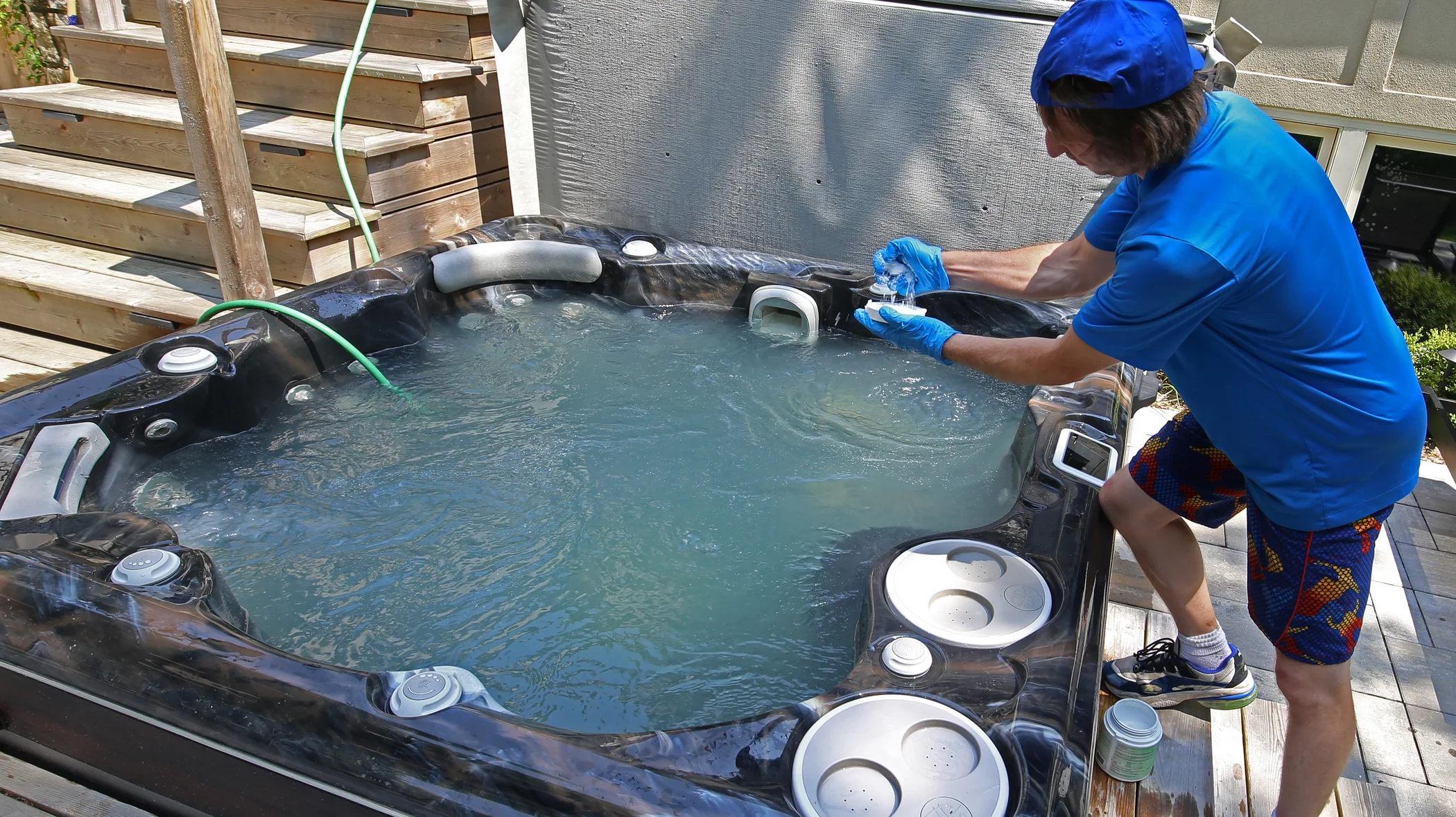Can You Put Pool Chemicals in a Hot Tub?

If you own both a hot tub and a swimming pool, you’ll surely also own a hefty stack of chemical additives for both. If you’ve casually looked at these chemicals, you might think there’s no difference between hot tub chemicals and swimming pool chemicals.
That’s why we think we we get asked about mixing chemicals or using pool chemicals in hot tubs at Hydropool. They look so much the same, they must be able to swap for each other, right?
However, if you look closer, you’ll notice that the swimming pool chemicals come in much higher concentrations than those made for the hot tub.
For this reason, and several others, if you’re asking the question, “Can you put pool chemicals in a hot tub?” you’ll understand why the answer is “No.”
In this article, we will go over the following areas:
- Water Volume
- Water Temperature
- Water Circulation
- Evaporation
- Water usage
- Chlorine tablets
- pH
By the end, we hope you’ve got a strong sense of why pool chemicals should stay in your pool and why you need your own hot tub supply of chemicals.
How Does Water Volume Affect Hot Tub Chemicals?
A swimming pool holds much more water than a hot tub. It’s for this reason that swimming pool chemicals are manufactured to have much higher chemical concentrations than those made for hot tubs. These higher concentrations allow swimming pool owners to avoid carrying and storing massive quantities of chemicals.
But these same highly concentrated chemicals can cause wild fluctuations in the pH levels, total alkalinity measurements and chlorine levels in the small volume of water found in a hot tub.
How Does Water Temperature Affect Hot Tub Chemicals?
Hot tub water can run a good 15C higher than that found in a swimming pool. The higher water temperatures found in a hot tub accelerate chemical reactions and cause more of them to occur compared to those taking place at the lower temperatures found in a swimming pool.
Because swimming pool chemicals are already manufactured in higher concentrations, their use in a hot tub can cause rapid and uncontrollable fluctuations in the various levels that need to be kept in balance.
How Does Water Circulation Affect Hot Tub Chemicals?
The fact that hot tubs have a higher concentration of water jets per square foot than a swimming pool means water is circulated much faster in hot tubs. This faster mixing of the water causes chemical reactions to occur more quickly.
Combined with highly concentrated swimming pool chemicals, this will also cause uncontrollable fluctuations in the water balance levels.
How Does Evaporation Affect Hot Tub Chemicals?
The high temperatures and churning waters of a hot tub inevitably lead to water evaporation. This evaporation, in turn, causes the levels of chemicals in the water to become more concentrated.
Hot tub chemicals are manufactured to take this level of evaporation into account. Swimming pool chemicals, which are more concentrated, to begin with, can become super concentrated if used in a hot tub. This can result in skin irritation and/or equipment damage.
How Does Water Usage Affect Hot Tub Chemicals?
Because of their greater capacity and the way that swimming pools are used, there is typically much more activity found in a swimming pool than a hot tub. The reduced water usage in a hot tub makes it more vulnerable to dramatic changes in pH, total alkalinity and chlorine levels. If swimming pool chemicals are used in a hot tub, these changes can be especially unmanageable.
How Are Chlorine Tablets Different for Hot Tubs and Pools?
Chlorine tablets made for a swimming pool are too acidic to be used in a hot tub. They can reduce the water’s buffering capacity which can cause a severe drop in pH. Rebalancing the water to allow bathing could possibly take days.
How Is pH Different in a Swimming Pool and a Hot Tub?
Swimming pool soda ash, used to raise pH levels, is much too concentrated to use in a hot tub. The combination of a small volume of water and high temperatures can cause pH levels to skyrocket to such a point that the only way to rectify the situation is to empty the tub and refill it with fresh water.
Can I Use Swimming Pool Chemicals in My Hot Tub?
We sometimes see people trying to make the calculations intended for large amounts of water into the tiny equivalent of a hot tub. They call us at Hydropool or come in with pool products, asking for help.
We get why they are trying. It makes sense that the products are similar. But they aren’t the same and the main element is the amount of concentration in swimming pool water products. That concentration is out of whack for the smaller environment of the hot tub, and will make it difficult to impossible for you to use the pool chemicals in your tub.
We say the best and most important thing you can do is not to bother with trying to figure out how your pool chemicals can work in your hot tub – and in this article we went through all the reasons why! We say buy the specific products made for hot tubs. There’s a little bit of cost involved but it’s worth it, to put your mind at ease and to have the products you know will get the job done with a minimal amount of hassle.
If you have any more questions, please don’t hesitate to reach out! Find the closest retailer to you here.






